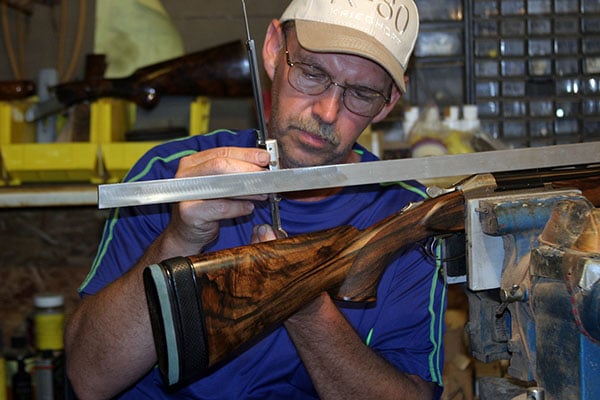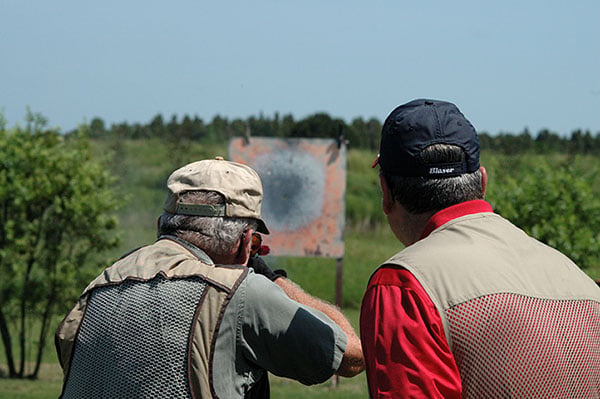
Last Updated on
-By Luke Brandenburg–
Although many shooters overlook the importance of gun-fitting, it is impossible for a shooter to reach his or her full potential without finding the perfect fit. Become a better shooter! Learn how to check your fit and fine tune it to perfection.
Whether you’re gearing up for duck season, preparing for a sporting clays competition or just trying to perfect your shooting performance, overlooking the importance of your shotgun fit can be a serious mistake. Factory shotguns are manufactured to fit the “average” shooter, but many of us just don’t fit that mold. Those with any slight differences than this “average” model can experience an array of different shooting issues.
Those with any slight differences than this “average” model can experience an array of different shooting issues. By fine tuning your shot gun fit, you can avoid many of the problems other shooters never figure out.
Checking Your Shotgun Fit
When most gun-fitters test a shotgun’s fit, they use a 3-4 foot square plate of steel covered with paint or any other material that will show where the pellets are striking the plate. If you don’t have a steel plate laying around, a plastic tablecloth or an old sheet will do the job just fine.
Hang up your patterning material and create a 2-inch wide mark in the center for aiming. Then, put the tightest choke you have available in your shotgun barrel and shoot at the center mark from approximately 16 yards. Start in an un-mounted position and raise the gun naturally up to your cheek. Keep your eye on the target and fire the moment your shotgun hits your shoulder. Do not try to correct your aim or use the aiming beads.
Once you hit the target, put down your shotgun and look at where the pattern landed on your sheet or plastic target. If the center of the pattern is above or below your center aiming mark, the drop of your stock will need to be altered. If the center is off to either side of the aiming mark, you should adjust your cast. At a firing distance of 16 yards, every inch from the center will require a change of approximately 1/16th of an inch in stock dimensions.
Altering Your Drop
Think of the drop of your stock as the elevation mark on your rifle sight. Altering the drop of your shotgun is comparable with making elevation changes to the sights of your rifle. The drop is simply the distance from the top edge of your stock to the top of your shotgun’s barrel or rib. It is measured at the heel and at the front of the comb.
A professional gun-fitter or gunsmith can help you make precise adjustments to the drop of your gun’s stock, but depending on the severity of your drop problem, you may be able to do make some adjustments on your own.
Lengthening your stock can be an easy way to increase your drop. Although this does not actually alter the gun’s dimensions, it does pull your cheek back from the mechanism, which effectively increases your drop. For semi-automatic and pump shotguns, you can increase your drop by loosening your stock bolt and inserting wood shim between the head of the stock and the back of the receiver. Make sure the shim you use is very thin, as even a flattened toothpick could alter a gun’s drop by as much as a half of an inch.
Personal preference also comes into play when adjusting stock as some shooters prefer a gun that shoots just a little high. A gunsmith can help you make any adjustments necessary to fit your personal style.
Adjusting Your Cast
The cast on your shotgun would correspond to the windage adjustment on your rifle sights. It represents a slight lateral bend in the stock that allows your dominant eye to be centered easily over the rib. Most American-made gunstocks come with no cast, but any shooter with a round face or narrow-set eyes will need cast.
The direction of the cast depends on the dominant hand of the shooter. Lefties need a slight bend to the left, often referred to as “cast on,” while righties need “cast off.”
On pump and semi-automatic shotguns, the cast can be adjusted roughly using a very thin shim. The shim should be placed lengthwise along the head of the stock in the opposite direction of the way you need the stock to bend. Professional gunsmiths can do cast adjustments precisely and permanently using heat lamps and hot oils.
Length of Pull (LOP)
Technically, the length of pull, or LOP, represents the distance between the center of the shotgun butt and the front of the trigger mechanism. To find your unique LOP, have someone measure the distance between the knuckle of your thumb and your nose when in a mounted position. This measurement should be approximately 1 ½ inches, or two finger-widths.
Your shotgun stock should be short enough to allow for easy mounting, but it should also be long enough to ensure that the gun does not need to go a long way back to your shoulder (which can make it much easier to miss a target). You can add length to your stock by using recoil pads and spacers, but cutting length out can be difficult without the help of a gunsmith. It is very easy to unintentionally alter the pitch of the butt and other important dimensions when cutting a stock down.
Pitch and Toe-Out
The pitch and toe-out measurements are some of the most commonly overlooked dimensions when fitting a shotgun. Both of these dimensions can be adjusted to make your gun much more comfortable to fire. The pitch refers to the angle of your butt pad when compared to the barrel/s.
The butt of your shotgun should always make full contact with your shoulder so that recoil can be distributed evenly. Some shooters experiment with the pitch by placing quarters between the butt and recoil pad. Face slap, or an upwards kick, may be counter-acted with spacers at the top of the butt, while a downwards kick may require spacers at the bottom of the butt.
Shooters who have problems keeping their shotgun from tilting, or canting, should first consider adjusting the toe-out angle. The toe-out angle refers to the distance the bottom butt plate is pushed outwards. Women often benefit from stocks with toe-out. By simply removing the bottom screw of the recoil pad and twisting the pad outward, you can experiment with toe-out angle.
Depending on your skillset, you may be able to make some slight adjustments to your shotgun on your own. However, those who are serious about fine tuning their shotgun fit should seek a professional gun-fitter or gunsmith.





Comments (0)
2015 Articles In Review | The Blog of the Gritr Sports Storesays:
December 31, 2015 at 2:38 pm[…] covered a subject that many never think about when they purchase a shotgun: gun fitting. In How To Fine Tune Your Shotgun Fit, Brandenburg reminds us that factory shotguns are tailored to fit the average shooter, and most of […]